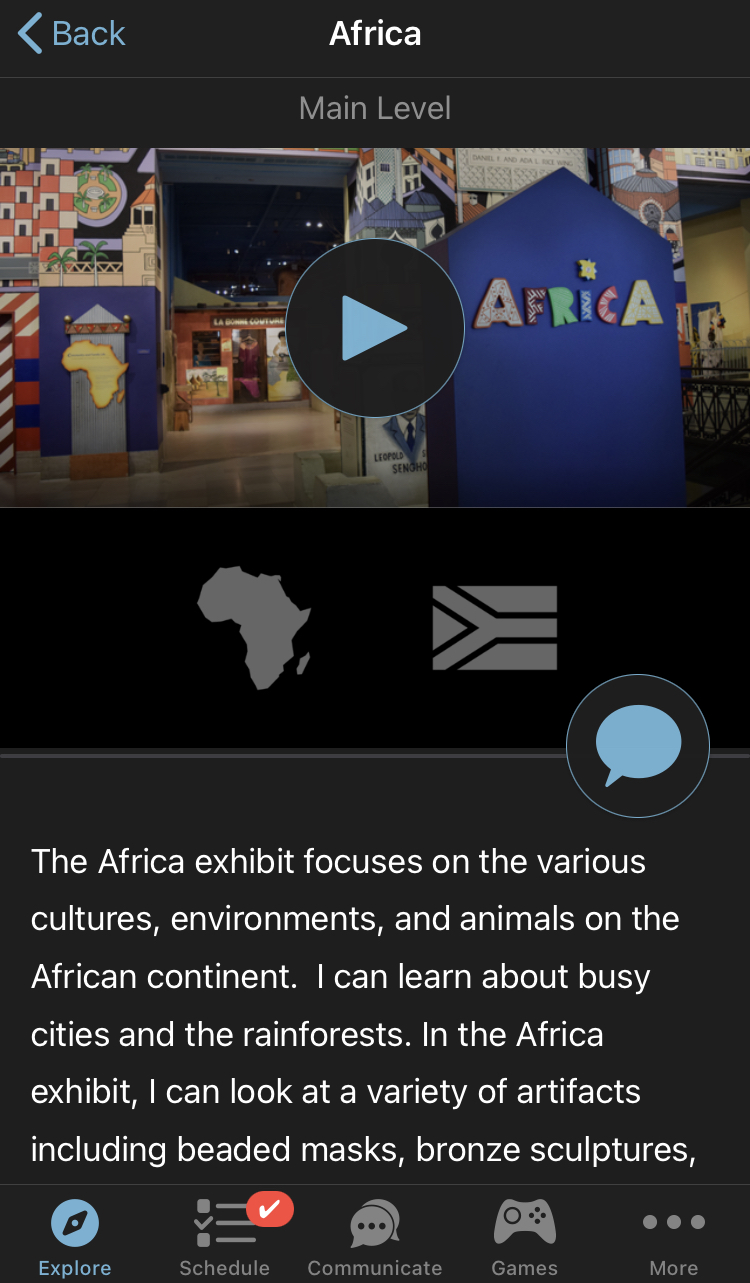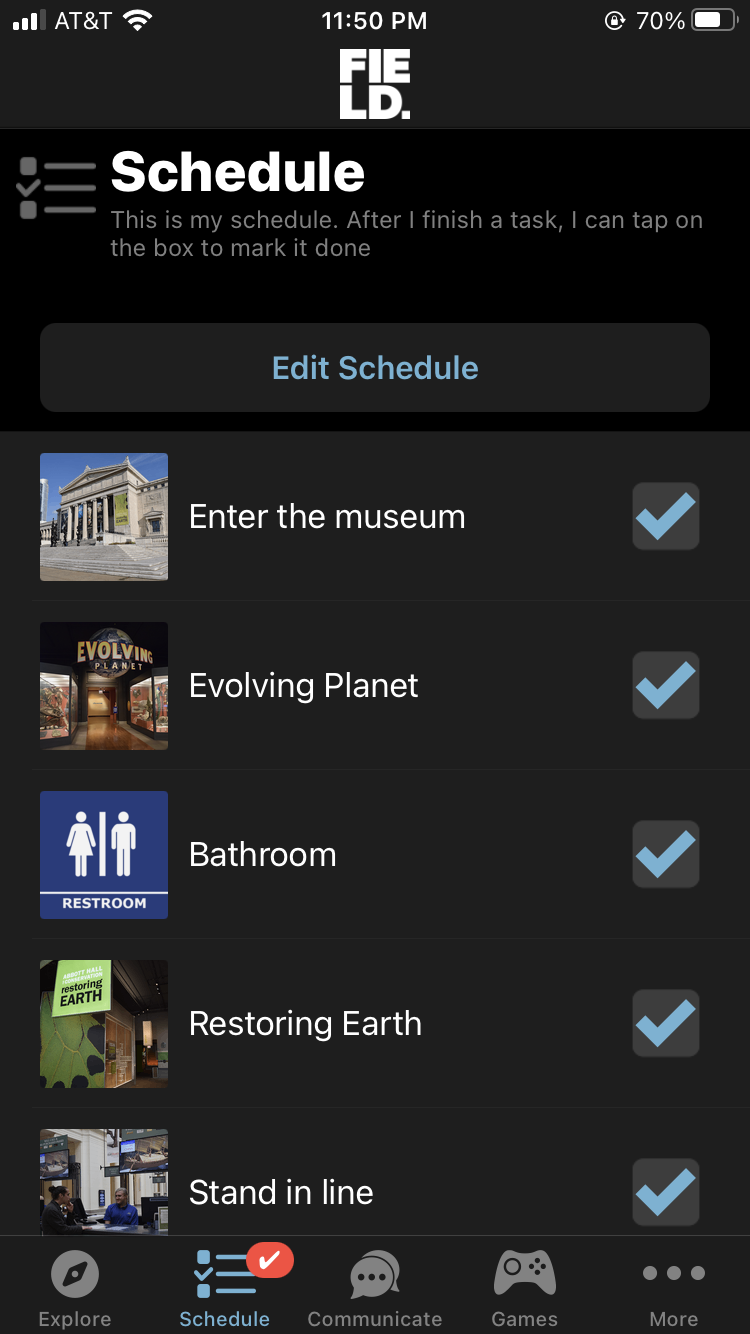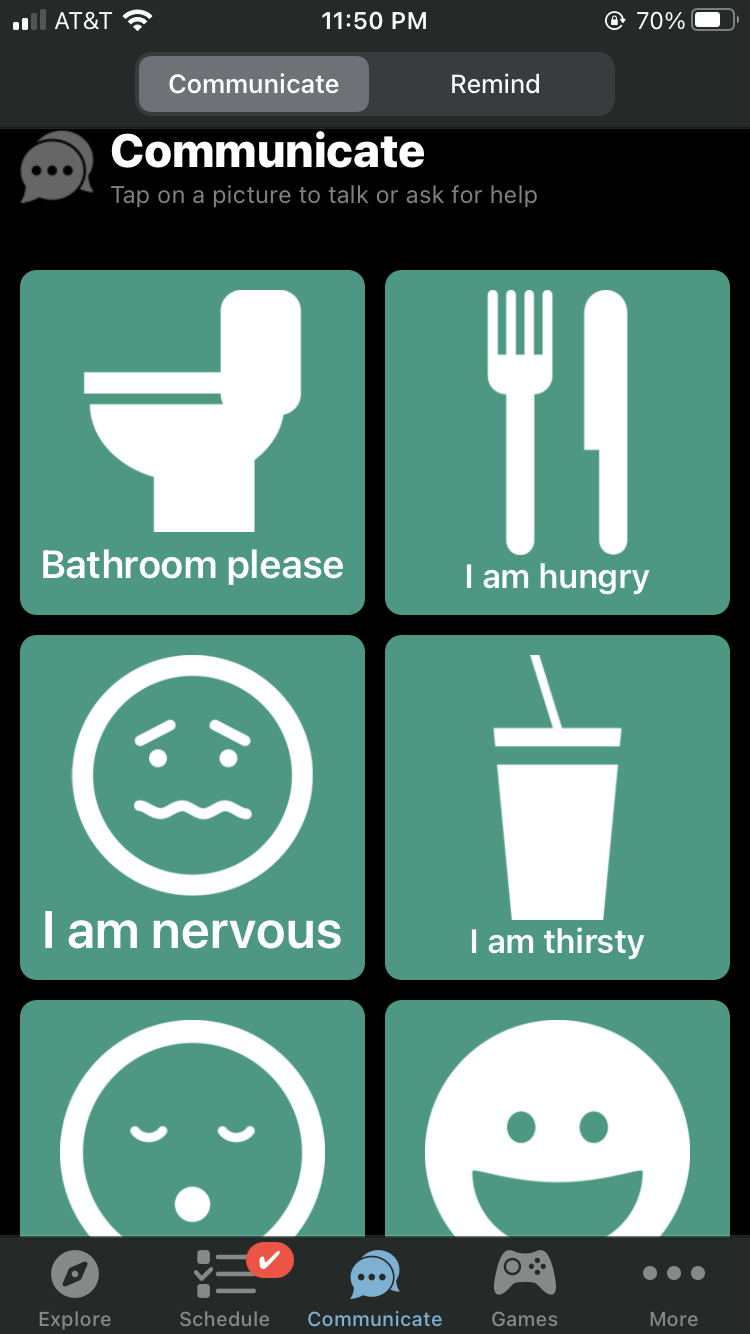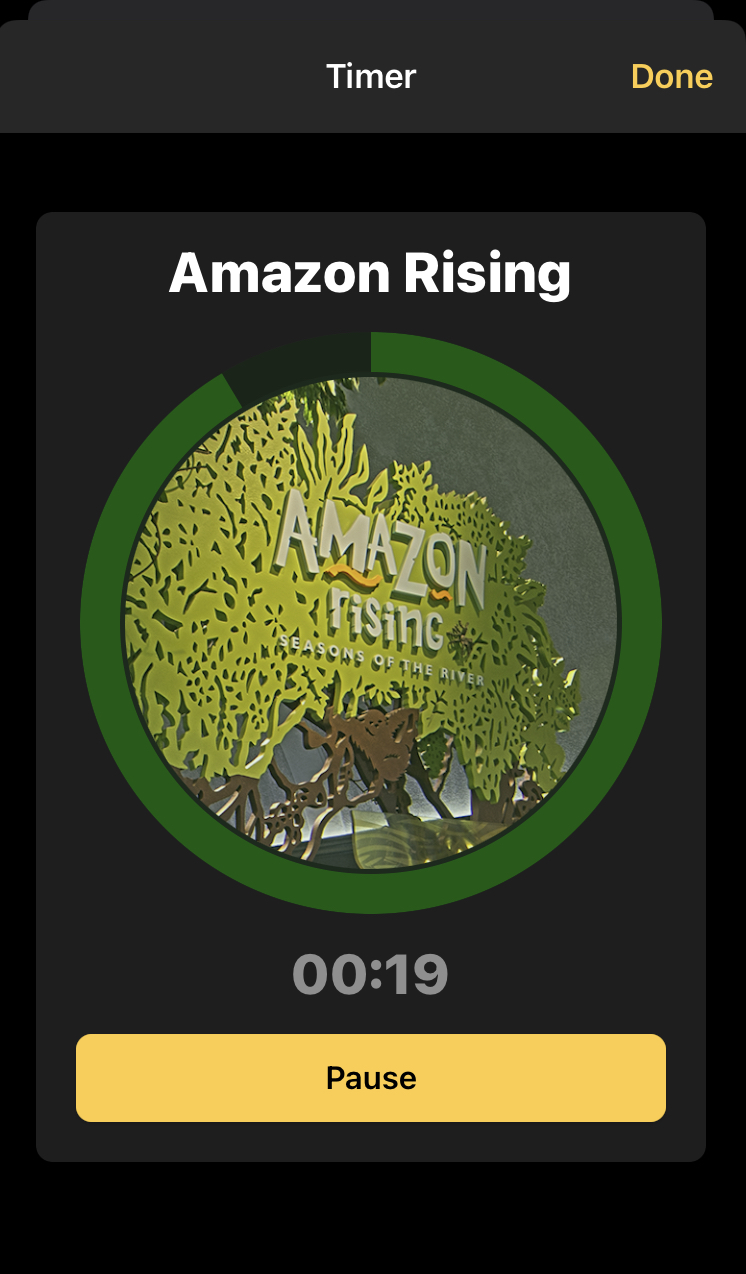XII. Apps and Autism: Mobile Applications Creating Accessibility in Museums
- Montana Coward, The George Washington University
For many decades museums have had to grapple with the questions of how to make their exhibition spaces accessible for all people. The 1990 passage of The Americans with Disabilities Act (ADA) pushed museums to become more accessible for individuals regardless of their physical circumstance. However, not all disabilities are physical. In order for museums to successfully create meaningful experiences for all visitors, they must consider the diversity of their visitors, including those who are neuro-divergent.
For many families visiting a museum is a fun and exciting time. For other families, especially those who have children with autism, visiting museums can pose a special set of challenges. The difficulties can range from sensory overloads, due to lights and sounds, to anxiety around a deviation from their daily routines. One tool that can be used to alleviate some of those difficulties is technology. Specifically, technology in the form of autism-focused museum apps developed by Infiniteach. This paper will offer an overview and review of the Infiniteach apps and consider their uses in supporting children who are nuero-divergent during their museum visits. Specifically, the Field Museum and the Shedd Aquarium’s autism-focused apps will be analyzed in order to consider how they may affect a user’s museum experience.
What is Autism?
Autism or ASD is a neurological disorder that affects the development of a child’s social skills, communicative competences, and can cause behavioral challenges.1 By the time a child is two the signifying behaviors of ASD are generally apparent, though many children are not fully diagnosed until they are older.2 The Centers for Disease Control and Prevention (CDC) reported on data from 2016 stating that approximately 1 in 54 or 1.85% of children living in the United States are diagnosed with ASD.3
ASD is not a one-size-fits-all disorder. Some individuals with ASD need very little assistance, whereas others may need a great deal of assistance in their day-to-day lives. Currently there is no single conclusive medical test that is able to diagnose ASD.4 Therefore, diagnoses rely on observed behaviors. According to the CDC, in order for a child to be diagnosed with ASD they must exhibit persistent deficits in all three of these social communication and interaction areas: social-emotional reciprocity (an individual’s ability to engage in social interactions between two or more people), nonverbal communicative behaviors used for social interaction, and developing, maintaining, and understanding relationships.5 In addition to meeting all three of the social communication and interaction criteria, the child also has to exhibit at least two of the four following types of restricted (limited range of focus, interest, or activity), repetitive behaviors: stereotyped or repetitive motor movements, insistence on sameness or inflexible adherence to routines, highly restricted or fixated interests, or hyper/ hyporeactivity to sensory input or unusual interest in sensory aspects of the environment.6 The severity at which these traits may appear vary heavily from individual to individual.
Challenges Museums Pose
Navigating new places can be tough for anyone, but it can pose a particular challenge for children with autism. According to the National Autistic Society, many children who have been diagnosed with ASD have a hard time adjusting to new environments outside of their daily routines.7 Additionally, not knowing what to expect at a museum may cause extra stress. Long lines and large crowds at exhibitions can also pose a challenge for a child with ASD.8 Another barrier that may be a challenge for children with ASD to visit museums are the sensory overloads that come from the changes in lighting and noise levels around the museum.9 While all of these challenges make visiting a museum difficult, technology may be able to help mitigate them.
Infiniteach and Apps
Infiniteach is a company that has embraced the unique challenge of creating museum apps that are catered to the needs of children with ASD. Each of the three co-founders of Infiniteach has a background in working with children who have been diagnosed with ASD. Two of the three are former Special Education teachers, while the third worked as an at home therapist for children with ASD.10 Due to their past experiences, the co-founders of Infiniteach understand the complex needs children with ASD have and are able to address some of them in their apps. Infiniteach focuses on creating apps that use evidence-based strategies to reduce anxiety and increase engagement.11
The Infiniteach apps are located in both the Apple and Android app stores. It can be downloaded on an iPhone, iPad, and iPod touch, with an iOS 9.0 or later12 , along with an Android 5.0 or higher.13 Each app has been downloaded over 1000 times. On both platforms the app is rated for everyone. Although the app is geared towards the ease of use for children, it could also be a useful tool for adults with ASD. The intended use of the app is for children to be able to interact with it while in the museum, however, it also has features that are meant for the caregiver to operate, such as schedules and timers. The specific features of the app will be further discussed in detail in later sections.
The apps that Infiniteach creates are particularly impressive considering most museum apps are mainly being used to help the visitor plan for their future visit to the museum by providing visitors with the basic information: what is in the exhibits, the museum’s hours, the pricing of tickets, and possibly a special event.14 Another common use of museum apps is for visitors who are in the physical museum space to use as a map or sometimes even provide self-guided tours.15 While these uses of museum apps can be very helpful for some visitors, they are not designed specifically for children with ASD in mind.
Case Studies
The Field Museum
The Field Museum’s app by Infiniteach has four main features: the Explore page, the Schedule, the Communicate page, and the Sensory Friendly Map. The Explore page gives children with ASD the opportunity to access the information about each exhibit in the most effective way for them. The Explore page has several different options to provide children with ASD information about the exhibit, to enable each child the opportunity to access the information in the most personally effective way. The best way to understand the information may be by reading it themselves, having the app read it to them, or by watching a video. The information is all the same regardless of the way the child chooses to access it. In the information section the phrases “I can” and “I might” are used throughout. These phrases help to build social narratives. Social narratives are defined as, “simple stories that visually represent social situations and appropriate social behaviors.”16
While social narratives have had mixed reviews in terms of effectiveness17, the National Professional Development Center on Autism Spectrum Disorder classifies the use of social narratives as an evidence-based practice.18 Social narratives are important because they illustrate socially acceptable behaviors, “The social narrative connects the important details of a setting or social situation to support the person with ASD in understanding the social context and in developing a new social skill.”19 There are normally five elements that make up a social narrative: the description of a situation, the perspective that describes a feeling or opinion, the directive such as “I can”, the affirmative that provides reassurance, and the co-operative that describes other people’s behavior.20 For example, the information section for the Stanley Field Hall & Science Lab explains a social interaction that may occur in the museum, “In the Science Hub I can interact with a museum educator who can sometimes let me touch things.”21 The use of social narratives in the app’s information section may help a child with autism by presenting them with a situation they will face in the museum and positively affirming acceptable behaviors. Social narratives may also help children with autism that struggle with new environments, due to their insistence on sameness, become acclimated with the space they will visit before getting to the museum. This may allow for a less stressful experience when in the physical museum.
In addition to explaining the exhibit and the social situations that may arise, the app also describes the sensory levels in an exhibit space within the information section. For instance, at the end of the Stanley Field Hall & Science Lab information section it communicates the environment in the exhibit, “Stanley Field Hall is also usually busy with lots of people.”22 The information section goes on to suggest places that are less populated to rest, “If I need a break from Stanley Field Hall, I can go into a quiet exhibit nearby, like the Hall of Mammals or the Hall of Birds.”23 This type of information may help children that struggle with a sensitivity to noise or who become overwhelmed in crowded areas to be better prepared for situations that make them feel uncomfortable. It also allows children with ASD the opportunity to completely opt out of going into that exhibit.
The Schedule section of the app gives caregivers the ability to tailor their museum experience to their child’s interests and needs. On the Schedule page of the app, all of the exhibits in the museum are listed. The schedule even has the addition of a time to use the bathroom, eat, stand in line, go to the giftshop and finally leave. It also allows families the flexibility to add customized activities such as “take a family photo”. For each of the items on the schedule there is a photo next to it, which helps create a visual schedule. Visual scheduling is defined as “a systematic technique that enhances learning and communication for individuals with ASD.”24 Visual schedules work to remind the child where they’re supposed to be and what they are supposed to be doing.25 It also creates a sense of predictability, because the child can see what will come next, which may help children that struggle with changes and transitions. This may lessen the anxiety of transitioning to the next activity. This is especially important in a museum setting because exhibits can vary greatly in their environments. Another feature to the schedule is an interactive element where after a task is completed a check mark can be added next to the task to signify its completion. This feature is useful because it shows what has already been accomplished and what is still left to do. This is another element that could reduce the uncertainty that a child with ASD may feel when visiting a museum.
On the Communicate page there are many different pictures that are associated with feelings or actions. When a picture is pressed the app will read aloud the button that was pressed. The buttons range from “bathroom please”, to “I like this place”. It also has a tab that serves as reminders such as, “wear my mask” and “hold my hand”. These features can be helpful for non-verbal children or for children who are feeling overwhelmed. When children with ASD start to feel overwhelmed they may have a meltdown, which is normal. A meltdown differs from a regular tantrum because meltdowns are not bad behavior but a response to an overwhelming situation.26 Sometimes the result of a meltdown leads to a suppression of motor skills that may make it difficult for a child to express their needs. One of the ways to help a child with ASD to communicate during a meltdown is through pictures. The app’s communication feature could allow a child to express their emotions and feel more understood. This is particularly helpful for visiting a museum where there are a lot of people, lights, and sounds that may overwhelm them.
Another tool on the app to help mitigate sensory overloads is the Sensory Friendly Map. The map has the layout of each floor of the museum with the exhibits labeled like a regular map. A key feature of the Sensory Friendly Map is that it has an array of symbols that represent different sources of stimuli. At the bottom of the map there is a map key explaining all of the different symbols, so it is easy to understand. The symbols include different aspects of environmental changes such as areas that are loud, quiet, or that have bright lights. It also highlights locations where there are things that can be touched and places that have movement opportunities. The map allows children with ASD to know what the environment is like for each of the areas of the museum. It can help children know where good places to rest are or places to avoid, especially if they are already feeling overwhelmed. Having the sensory features on the maps can help families that have children with ASD plan a trip that will best suit their sensory needs.
Shedd Aquarium
The Shedd Aquarium’s autism-focused app is created by the same company as the Field Museum’s app, Infiniteach. The apps are almost identical in their structure. The Shedd Aquarium app has the Explore page, the Schedule, a Tool page, and the Sensory Friendly Map. The core difference between the apps is that the Shedd Aquarium’s app has an updated suite of features not seen on the app used by the Field Museum. For example, on the Schedule page there is a way for the caregiver to set a timer in the app for a specific section of the museum. The timer depicts a picture of the exhibition along with a visual representation of the time passing and the actual time left in numbers. The timer feature is a great addition because it allows children to know and see how much time they have left at each exhibit. This may cause less anxiety when transitioning to a new section of the museum because they can see how long until the activity they are currently doing ends and their next activity begins. This may allow children with ASD to feel less anxious and feel more in control of their situation.
The other feature that was enhanced was the Communication page. In this app the Communications page is now housed under the Tools page. The Tools page also has a timer and reminders function. Following the pattern of the Field Museum’s app, the Shedd Aquarium’s Communication page is used by the child in order to communicate with the people around them (be that a parent, caregiver, teacher, or museum staff etc.). On the Shedd Aquarium’s Communication page there are more options of things to communicate. The app breaks down different actions or emotions based on the exhibit. For example, for the Oceanarium exhibit there are buttons and pictures for, “When does the presentation start?”, “look at the sea lion!”, and “I can clap”.27 This version of the app has all of the communications from the Field Museum’s app but also allows the child to express more of their experiences in the museum and ask questions. The expansion of communicators can be helpful for children with ASD who struggle with expressing their experiences. It offers them an accessible way to engage with the museum around them and share their experiences with others.
Benefits/ Limitations
The Infiniteach autism-focused app has very thoughtfully addressed many of the stressors that a visit to a museum may cause a child with ASD. This app has the potential to lessen some of the anxieties of visiting a new place for the first time by explaining what to expect in each of the exhibits. It also has the ability to not only help prepare the child for the museum, but also works as a great tool in the museum with the Communication page and Sensory Friendly Map. One of the limitations to the app is that autism is a wide spectrum, so a one size fits all approach may not be as beneficial to some individuals as it is to others. While the features may be very helpful for some children, for others they might be altogether unnecessary. An example of this is the Communication page. Though it is useful for children who cannot read, due to the pictures, it is most beneficial to children who are able to read. Another limitation of the Communication page, even for the updated Shedd Aquarium, is that it is very limited on what can be communicated. Additionally, a limitation of the app in general is that in order for it to be useful, potential users have to know that it exists, and be able to download the app. While the apps are available in both the Apple and Android app stores, it does exclude those who do not have a smartphone or smart devices.
Conclusion
Museums should be a place where every visitor feels comfortable and welcomed into the space. For some individuals, such as children with ASD, it may take more help for them to feel comfortable and welcomed. This is where technology, particularly the Infiniteach apps, may be used as a tool that can reduce some of the environmental stressors and anxieties that come with a museum visit. Not only can this app make navigating and learning about the museum more accessible to children (and individuals of all ages) with ASD, it also invites the user to engage with the museum space they are visiting. The Infiniteach app, though not the complete solution for all things in relation to accessibility for the neuro-divergent, has the potential to help children with ASD feel welcomed and included in museums.
Notes
-
“What Is Autism Spectrum Disorder?,” Centers for Disease Control and Prevention (Centers for Disease Control and Prevention, March 25, 2020), https://www.cdc.gov/ncbddd/autism/facts.html. ↩︎
-
“What Is Autism Spectrum Disorder?,” Centers for Disease Control and Prevention (Centers for Disease Control and Prevention, March 25, 2020), https://www.cdc.gov/ncbddd/autism/facts.html. ↩︎
-
“Autism Statistics and Facts,” Autism Speaks, https://www.autismspeaks.org/autism-statistics-asd. ↩︎
-
“Autism Spectrum Disorder (ASD) Screening: Medlineplus Medical Test,” MedlinePlus (U.S. National Library of Medicine, August 31, 2021), https://medlineplus.gov/lab-tests/autism-spectrum-disorder-asd-screening/. ↩︎
-
“Diagnostic Criteria,” Centers for Disease Control and Prevention (Centers for Disease Control and Prevention, June 29, 2020), https://www.cdc.gov/ncbddd/autism/hcp-dsm.html. ↩︎
-
“Diagnostic Criteria,” Centers for Disease Control and Prevention (Centers for Disease Control and Prevention, June 29, 2020), https://www.cdc.gov/ncbddd/autism/hcp-dsm.html. ↩︎
-
“Making Museums Autism Friendly,” National Autistic Society - Leading UK charity for Autistic people, https://www.autism.org.uk/advice-and-guidance/professional-practice/museums. ↩︎
-
“Making Museums Autism Friendly,” National Autistic Society - Leading UK charity for Autistic people, https://www.autism.org.uk/advice-and-guidance/professional-practice/museums. ↩︎
-
“Making Museums Autism Friendly,” National Autistic Society - Leading UK charity for Autistic people, https://www.autism.org.uk/advice-and-guidance/professional-practice/museums. ↩︎
-
“Who We Are,” Infiniteach, https://www.infiniteach.com/about/. ↩︎
-
“Our Work,” Infiniteach, https://www.infiniteach.com/our-work/. ↩︎
-
Infiniteach Inc, “Field Museum for All,” Apple App Store, Vers. 1.71 (2020). ↩︎
-
Infiniteach Inc, “Field Museum for All,” Apple App Store, Vers. 1.71 (2020). ↩︎
-
Debbie Morrison, “Museum Apps: Why They’re Brutal and How to Fix Them,” Debbie Morrison, https://www.debbiemorrison.net/museumsforreal/museum-apps-why-theyre-brutal-and-how-to-fix-them. ↩︎
-
Debbie Morrison,“Museum Apps: Why They’re Brutal and How to Fix Them,” Debbie Morrison, https://www.debbiemorrison.net/museumsforreal/museum-apps-why-theyre-brutal-and-how-to-fix-them. ↩︎
-
Louise Southern, “Social Narratives Support Individuals with Autism,” Autism Society of NC, October 26, 2017, https://www.autismsociety-nc.org/social-narratives-guidelines/. ↩︎
-
Leaf, Justin B., ed. Handbook of Social Skills and Autism Spectrum Disorder: Assessment, Curricula, and Intervention. 1st ed. 2017. Autism and Child Psychopathology Series. Cham: Springer International Publishing : Imprint: Springer, 2017. https://doi.org/10.1007/978-3-319-62995-7. ↩︎
-
“Evidence Based Practices,” Autism PDC, https://autismpdc.fpg.unc.edu/evidence-based-practices. ↩︎
-
Louise Southern, “Social Narratives Support Individuals with Autism,” Autism Society of NC, October 26, 2017, https://www.autismsociety-nc.org/social-narratives-guidelines/. ↩︎
-
“The 5 Essential Elements of an Incredibly Effective Social Story,” LLA Therapy, March 1, 2019, https://llatherapy.org/the-5-essential-elements-of-an-incredibly-effective-social-story/. ↩︎
-
Infiniteach Inc, “Field Museum for All,” Apple App Store, Vers. 1.71 (2020). ↩︎
-
Infiniteach Inc, “Field Museum for All,” Apple App Store, Vers. 1.71 (2020). ↩︎
-
Infiniteach Inc, “Field Museum for All,” Apple App Store, Vers. 1.71 (2020). ↩︎
-
“What Is Visual Scheduling?,” Applied Behavior Analysis Programs Guide, May 8, 2020, https://www.appliedbehavioranalysisprograms.com/faq/what-is-visual-scheduling/. ↩︎
-
“What Is Visual Scheduling?,” Applied Behavior Analysis Programs Guide, May 8, 2020, https://www.appliedbehavioranalysisprograms.com/faq/what-is-visual-scheduling/. ↩︎
-
“Meltdowns - A Guide for All Audiences,” National Autistic Society - Leading UK charity for Autistic people, https://www.autism.org.uk/advice-and-guidance/topics/behaviour/meltdowns/all-audiences. ↩︎
-
Infiniteach Inc, “Sensory Friendly Shedd Aquarium,” Apple App Store, Vers. 1.75 (2020). ↩︎





